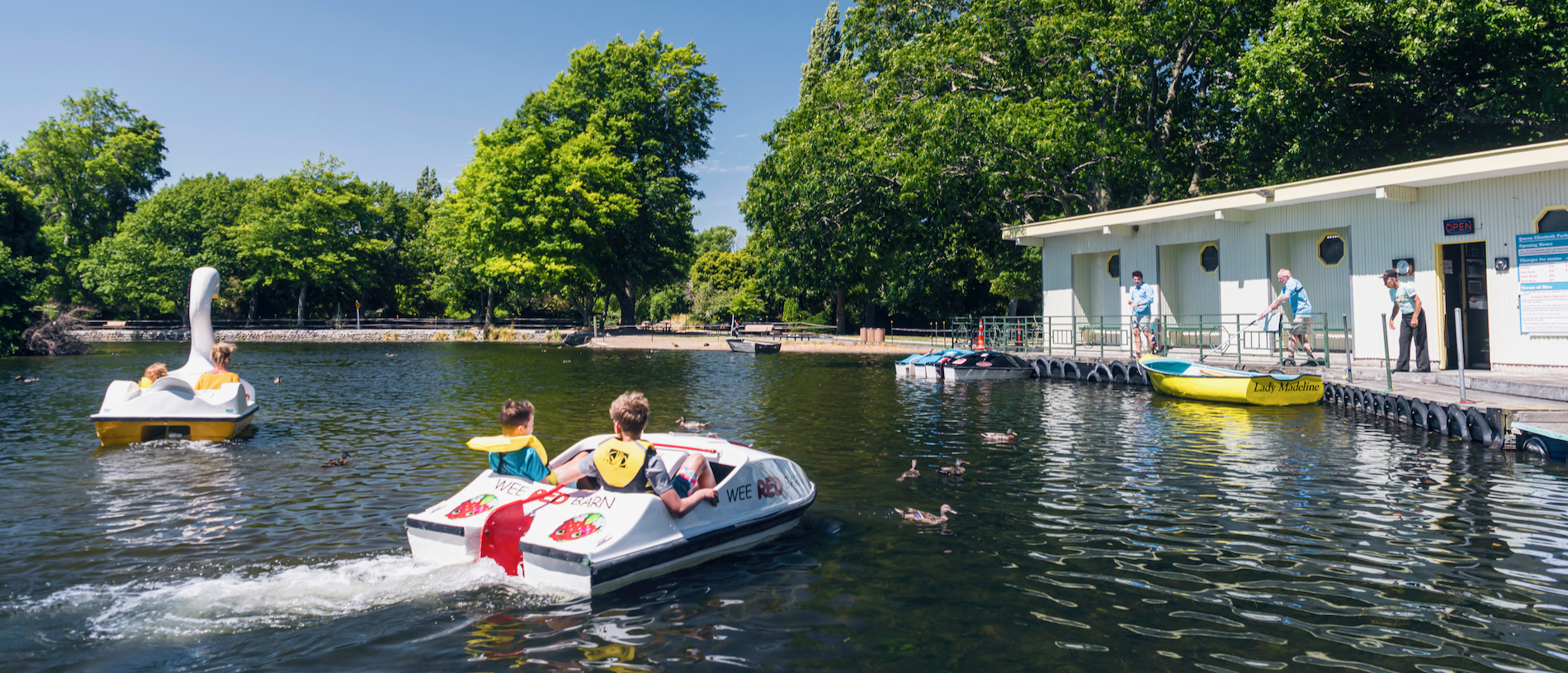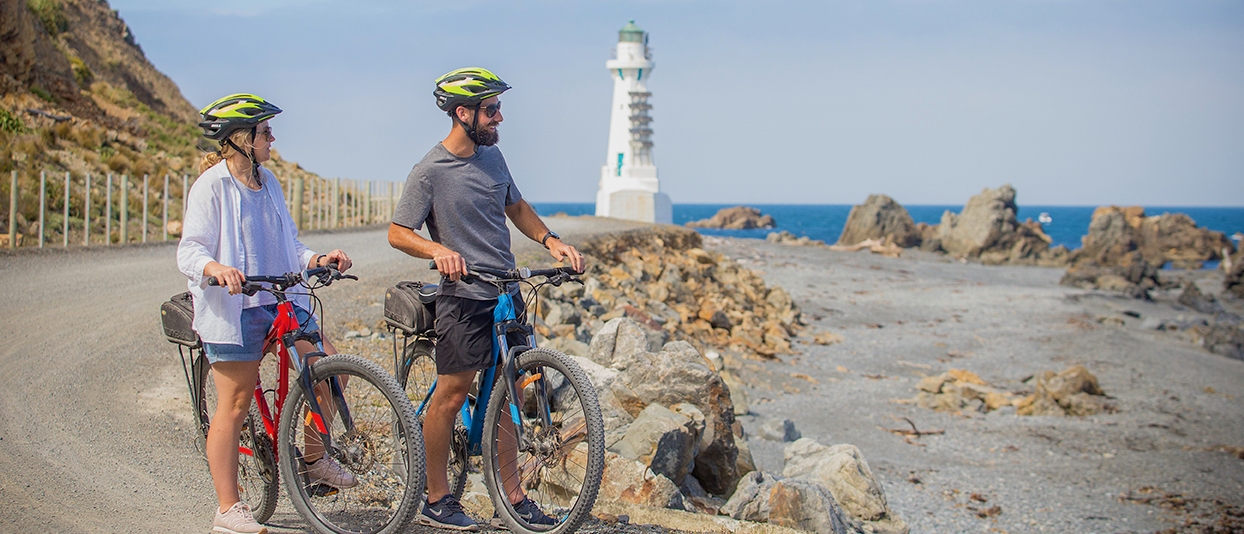
Queen Elizabeth Park: family-friendly fun
Explore one of New Zealand’s best family-friendly parks in Masterton.

From an artesian water spring to a literary walk, a historic lighthouse, an intriguing museum, river adventures and fossils, we've got 11 more Kiwi Gems for you to discover in Wellington and Wairarapa.
The Attic is on the fourth floor of Wellington Museum, in the heritage 1892 Bond Store on Jervois Quay on city’s waterfront. As attics ought to be, it’s a compelling and intriguing place, filled to the brim with fascinating things. Unlike traditional museum exhibition spaces, The Attic has an informal, quirky approach with each display telling a different story, weaving the contemporary with the historical, planting twists and turns to encourage visitors to have a good old rummage around. It’s a treasure trove of discovery, with a healthy dose of playfulness, featuring (among much else) records of Wellington’s UFO sightings, a time machine, costumes from the movie What We Do in the Shadows and two taxidermied lions.
Petone is known for many things – great cafés, a lovely stretch of sandy beach and the most artistic water source in the region. Yes, you read that right: shortly after the first European settlers arrived in Petone in 1840, they discovered that pure artesian water lay beneath the area. The water is naturally filtered through the alluvial gravels and sands of the Hutt Valley over several years before reaching Petone and flowing out to the sea. Today, those in the know come to Te Puna Wai Ora – meaning the spring of life – in Buick Street where you can not only fill your water bottle for free, you can also admire the sculpture/fountain.
It’s one of the jewels in Waikanae's tiara – Ngā Manu Nature Reserve, a 15-hectare bird sanctuary thick with picnic areas, bush walks and aviaries which has been doing great things with flora and fauna since 1981. A key attraction is the Nocturnal House where a pair of Brown kiwi live (another pair of kiwi live in an outdoor enclosure where they can be viewed). If you can, time your visit for the Kiwi Night Encounter which runs every Thursday to Sunday and provides a rare opportunity for visitors to get up close with our native birds. If that’s not possible, don’t miss feeding time – 2pm for the reserve's endangered long-fin eels or late morning for the guided bird-feeding tours.
Need to stretch your legs? Head to the Kāpiti Coast for one of the region's most stunning walks. The Paekākāriki Escarpment Track is part of the national Te Araroa Trail. Opened in 2016, this 10km path is chiselled into the hills about the Tasman Sea, between Paekākāriki and Pukerua Bay. You can do it in around 2.5 hours but allow time to take lots of photos because the views across the water and, on a good day, to the South Island in one direction and Mount Taranaki in the other, are pretty spectacular. The walk is great for families, but it is not recommended for the faint-hearted: you’ll scale around 1,200 very steep steps, navigate narrow pathways across ridge lines and traverse two swing bridges.
The Wellington waterfront is one of the city’s crowning jewels. The whole crescent from Chaffers Marina (where you’ll find Te Papa Tongarewa) to Queens Wharf is gloriously open, with a broad boulevard at the water’s edge lined with bars, restaurants and public artworks. But look a little closer and you’ll also find words. Chiseled into a series of secret concrete plaques are quotations from 23 noted New Zealand writers who have or had strong links to Wellington. There are literary giants here: Katherine Mansfield, Robin Hyde, Bruce Mason, Maurice Gee and Patricia Grace all called the capital home at some time in their lives. Each quotation is a perspective on the city and invites you to meditate as you walk. Either pick up a pamphlet from the library or information centre that will guide you from plaque to plaque, or you can let them surprise you as you stroll along the waterfront.
One of the loveliest waterfalls in the Wellington Region tumbles over a curving, human-made concrete structure in Upper Hutt. The historic Birchville Dam, constructed in 1929, once supplied water to the Upper Hutt area before the Kaitoke Scheme was established in 1954. Today, the scenic Birchville Dam waterfall is crystal clear and surrounded by native bush. Follow the well-maintained Cannon Point Walkway for about 25 minutes to reach the dam from Bridge Street or, for a longer walk, you can tackle the whole three-hour, 7.7km loop through the Akatārawa Forest.
Pencarrow Lighthouse at the rocky entrance to Wellington Harbour can be reached on a four-hour return walk or 1.5-hour bike ride from Eastbourne. The lighthouse is as scenic as it is historically significant. Not only is it New Zealand’s first-ever permanent lighthouse, it was initially operated by New Zealand’s first and only female lighthouse keeper, Mary Jane Bennett. From 1852 until the lighthouse was built in 1859 Mary and her husband George operated a light from a window of their isolated cottage at Pencarrow Head. After George died in a boating accident in 1855 Mary stayed on alone, raising her six children and single-handedly manning the 12m cast iron lighthouse until 1865.
In Greytown, stop to explore the Cobblestones Museum, with its replica early settlers’ village. Set amongst beautifully maintained gardens, the village is made up of buildings that have been relocated from around Wairarapa, each with their own fascinating story to tell. Back in the 1870s, Greytown was the halfway point on the four-day journey between Masterton and Wellington. The Hastwell Stables – the site’s only original building – was built back in 1857 and provided essential farrier, coach repair and stabling services for early travellers. Cobblestones Museum is a working historic village run almost entirely by volunteers. The museum is named after the well-preserved cobblestone courtyard, built as a solid surface for horses, carts, and passengers who used the original stables. Six original heritage buildings (Category 2 listings with Heritage New Zealand) were either already on site or relocated to Cobblestones to recreate how Wairarapa’s early settlers lived in the 1800s. Exhibitions, artefacts, tours and education programmes help visitors understand settlers’ stories and how they’ve influenced our modern world.
Did you know that at Whatarangi Bluff on the road to Cape Palliser, with a bit of fossicking, you can spot whalebone fossils that are up to 11 million years old? The incredible cliffs here are an attraction in their own right, with crumbling rocks descending to the rugged coastline. If you drive past the bluff and park on the right next to the shore, at low tide you’ll find well-preserved whale bone fossils encased in several of the the blue-grey mudstone boulders on the beach. This wild southern corner of the North Island is also home to a thriving kekeno New Zealand seal colony, the iconic Cape Palliser lighthouse and the famous Putangirua Pinnacles, so allow plenty of time to explore the area.
On the remote and rural road that leads from Masterton to Castlepoint you’ll find the Rewanui Forest Park. Threaded with several looped walking tracks, the 334-hectare park includes farmland, native bush and pine forest. The one-hour Tōtara Loop includes wonderful mature tōtara, hīnau and rewarewa trees. Or choose the two-hour Mount Clyde track for a steady 500m climb to the trig and great views over the Wairarapa countryside.
About 20 minutes south of Martinborough at at Ruakōkoputuna you’ll find Patuna Farm Adventures. The name is a giveaway. Here, you can explore a phenomenally photogenic limestone canyon, but be prepared to get very wet. A self-guided tour through private farmland will see you dropped at the entrance to the Patuna Chasm. Make sure you stop for photos at the impressive curve of Wave Rock. Then you’ll walk in the Ruakōkoputuna River to discover the magnificent mossy limestone archways of the chasm. Be aware that by the end of the walk you will be making your way through water up to 1m deep, so this experience is not suitable for young children. Sturdy footwear is absolutely required and don’t take anything that you don’t want to get wet! Patuna Farm Adventures is open for the summer season from 11 November until 2 April.